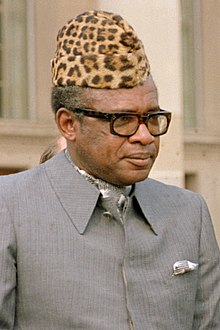Zaire
| République du Zaire | |||||
| Republic of Zaire | |||||
| 1971-1997 | |||||
|
|||||
|
Motto : " Paix, Justice, Travail " French for "Peace, Justice, Work" |
|||||
| Official language |
French next Kikongo , Lingala , Swahili and Tshiluba as national languages |
||||
| Capital | Kinshasa | ||||
| Form of government | republic | ||||
| Government system | Authoritarian one-party system | ||||
| Head of state , also head of government | President Mobutu Sese Seko | ||||
| currency | Zaïre (ZRZ) | ||||
| founding | October 27, 1971 | ||||
| resolution | May 16, 1997 | ||||
| National anthem | La Zaïroise | ||||
| Internet TLD | .zr (deleted 2001) | ||||
Republic of Zaire ( French République du Zaïre ) was from October 27, 1971 to May 16, 1997 the name of the Democratic Republic of the Congo in Central Africa.
Zaire was the third name given to the former colony of the Belgian Congo since independence from Belgium in 1960. The country became independent under the name Republic of the Congo ; because of the similarity in name to the neighboring state of the Congolese Republic ( Congo-Brazzaville ) it was also called Congo-Léopoldville . In 1964 it was named the Democratic Republic of the Congo to distinguish it , and in 1965 the Congolese Republic adopted the name Republic of the Congo .
Reasons for the renaming
While the first renaming to distinguish it from the neighboring country still had practical reasons, the claim behind the name Zaire was an alleged "Africanization" of the state name.
The name of the state was renamed on the instructions of the dictatorial ruling President Joseph-Désiré Mobutu, who "zairized" his own name to Mobutu Sese Seko (more precisely: Mobutu Sese Seko Kuku Ngbendu wa Zabanga). Mobutu had put himself to power in the wake of the so-called Congo turmoil in 1965 and when he took office there were actually a number of place names in the Congo that referred to the country's colonial past. The capital was still called Léopoldville, after the Belgian King Leopold II , under whose rule the most brutal phase of colonial exploitation of the Congo took place, which, under the name of the Congo Atrocities, had triggered worldwide outrage. The renaming to Kinshasa was therefore only logical for the sovereign state.
However, under Mobutu, the renaming policy became part of a state ideology that was referred to as authenticity or mobutism . Under the heading of authenticity , the renaming of places and people (Christian first names should be Africanized) were fundamentally ideologically inflated as a liberation from colonial degradation and neocolonialism , even in cases in which this argument was on weak feet. The state name "Congo", for example, could hardly be traced back to colonial roots, since it was already the name of the Kingdom of the Congo , and the new name "Zaire" had no tradition in the country.
Origin of the term
The term "Zaire" itself is of European origin: At the time of the first contact with the Portuguese in the 15th century, nzere or nzadi ("the river that swallows all rivers") was the name used by the local population for the lower reaches of the Congo. The Portuguese finally corrupted this to "Zaire". The province of Zaire still exists today on the lower reaches of the Congo in Angola .
History of Zaire
The history of Zaire is a phase in the history of the Democratic Republic of the Congo, so see the relevant section in History of the Democratic Republic of the Congo .
Historical names
| Historical naming of the territories of the Congo | ||
|---|---|---|
| former Belgian colony | former French colony (A) | former Portuguese protectorate |
| 1877 colonized | 1880 colonized (G) |
from 1885 Portuguese Congo |
| from 1885 Congo Free State | from 1903 Central Congo | |
|
from 1908 Belgian Congo |
1910 French Congo | |
| from 1958 Republic of the Congo |
1956 Portuguese Congo under joint administration with Angola |
|
| June 30, 1960 independence | August 15, 1960 independence | |
|
1960 Republic of the Congo (called Congo-Léopoldville ) 1960 Proclamation of the Free Republic of Congo by lumumbist insurgents (recognized by 26 states, after about a year smashed by government troops) |
1960 Congolese Republic (called Congo-Brazzaville ) |
|
|
1961 Federal Republic of the Congo (called Congo-Léopoldville ) [1] , [2] 1964 Proclamation of the People's Republic of the Congo by insurgents in Stanleyville (only recognized by 7 states, smashed by government troops after a few months) |
||
| 1964 Democratic Republic of the Congo (called Congo-Léopoldville ) [3] |
1965 Republic of the Congo (called Congo-Brazzaville ) |
|
| 1966 Democratic Republic of the Congo (called Congo-Kinshasa ) | ||
| 1971 Republic of Zaire |
1969 People's Republic of the Congo |
1974 Portuguese Congo occupied by Angola |
|
1991/92 (Congo-Zaïre) draft constitution of the National Sovereign Conference suspended by Mobutu |
||
|
since 1997 Democratic Republic of the Congo |
since 1991 Republic of the Congo |
since 1975 Cabinda , province ( exclave ) of Angola |
|
(A)as part of French Equatorial Africa
(G)1888–1910 Gabon was also part of the French Congo
|
||
literature
- Zaire . In: La Grande Encyclopédie . 20 volumes, Larousse, Paris 1971–1976, pp. 14753–14760 (French).
Individual evidence
- ^ IANA Report on Deletion of the .zr Top-Level Domain , accessed March 9, 2018
- ^ Peter Forbath : The River Congo. The Discovery, Exploration and Exploitation of the World's Most Dramatic River. Harper & Row, New York 1977, ISBN 978-0-06-122490-4 , p. 74
- ^ Dominic Johnson : Congo. Wars, Corruption and the Art of Survival. 2nd updated edition. Brandes & Apsel, Frankfurt a. M. 2009, ISBN 978-3-86099-743-7 , p. 44



